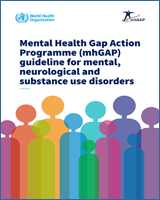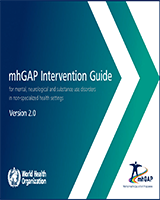Mental, neurological and substance use (MNS) disorders are highly prevalent, accounting for a substantial burden of disease and disability globally. In order to bridge the gap between available resources and the significant need for services, the World Health Organization launched the Mental Health Gap Action Programme (mhGAP). The objective of mhGAP is to scale-up care and services using evidence-based interventions for prevention and management of priority MNS conditions. The mhGAP Intervention Guide version 1.0 for MNS disorders for non-specialist health settings was developed in 2010 as a simple technical tool to allow for integrated management of priority MNS conditions using protocols for clinical decision-making.
With uptake in over 90 countries, mhGAP-IG 1.0 version has had widespread success. It is our pleasure to present mhGAP version 2.0, with updates incorporating new evidence-based guidance, enhanced usability, and new sections to expand its use by both health care providers as well as programme managers.
It is our hope that this guide will continue to provide the road-map to deliver care and services for people with MNS disorders around the world and lead us closer to achieving the goal of universal health coverage.
The designations employed and the presentation of the material in this publication do not imply the expression of any opinion whatsoever on the part of the World Health Organization concerning the legal status of any country, territory, city or area or of its authorities, or concerning the delimitation of its frontiers or boundaries. Dotted and dashed lines on maps represent approximate border lines for which there may not yet be full agreement.
The mention of specific companies or of certain manufacturers' products does not imply that they are endorsed or recommended by the World Health Organization in preference to others of a similar nature that are not mentioned. Errors and omissions excepted, the names of proprietary products are distinguished by initial capital letters.
All reasonable precautions have been taken by the World Health Organization to verify the information contained in this publication. However, the published material is being distributed without warranty of any kind, either expressed or implied. The responsibility for the interpretation and use of the material lies with the reader. In no event shall the World Health Organization be liable for damages arising from its use.


